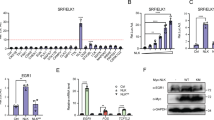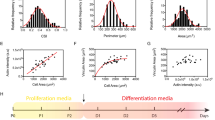Abstract
B-MYB is an ubiquitous protein required for mammalian cell growth. In this report we show that B-MYB transactivates its own promoter through a 120 bp segment proximal to the transcription start site. The B-MYB-responsive element does not contain myb-binding sites and gel-shift analysis shows that SP1, but not B-MYB, protein contained in SAOS2 cell extracts binds to the 120 bp B-myb promoter fragment. B-MYB-dependent transactivation is cooperatively increased in the presence of SP1, but not SP3 overexpression. When the SP1 elements of the B-myb promoter are transferred in front of a heterologous promoter, an increased response to B-MYB results. In contrast, c-MYB, the prototype member of the Myb family, is not able to activate the luciferase construct containing the SP1 elements. With the use of an SP1-GAL4 fusion protein, we have determined that the cooperative activation occurs through the domain A of SP1. These observations suggest that B-MYB functions as a coactivator of SP1, and that diverse combinations of myb and SP1 sites may dictate the responsiveness of myb-target genes to the various members of the myb family.
This is a preview of subscription content, access via your institution
Access options
Subscribe to this journal
Receive 50 print issues and online access
$259.00 per year
only $5.18 per issue
Buy this article
- Purchase on Springer Link
- Instant access to full article PDF
Prices may be subject to local taxes which are calculated during checkout







Similar content being viewed by others
References
Arsura M, Introna M, Passerini F, Mantovani A and Golay J. . 1992 Blood 79: 2708–2716.
Azizkhan JC, Jensen DE, Pierce AJ and Wade M. . 1993 Crit. Rev. Eukary. Gene Exp. 3: 229–254.
Berg JM. . 1992 Proc. Natl. Acad. Sci. USA 89: 11109–11110.
Bies J, Hoffman B, Amanullah A, Giese T and Wolff L. . 1996 Oncogene 12: 355–363.
Bies J and Wolff L. . 1995 Cancer Res. 55: 501–504.
Blake MC, Jambou RC, Swick AG and Kahn JW. . 1990 Mol. Cell. Biol. 10: 6632–6641.
Clarke MF, Kukowska-Latallo JF, Westin E, Smith M and Prochownick EV. . 1988 Mol. Cell. Biol. 8: 884–892.
De Luca P, Majello B and Lania L. . 1996 J. Biol. Chem. 271: 8533–8536.
Dennig J, Beato M and Suske G. . 1996 EMBO J. 15: 5659–5667.
Engelke UL, Whittaker L and Lipsick JS. . 1995 Virology 208: 467–477.
Foos G, Grimm S and Klempnauer KH. . 1992 EMBO J. 11: 4619–4629.
Golay J, Loffarelli L, Luppi M, Castellano M and Introna M. . 1994 Oncogene 9: 2469–2479.
Ibanez CE and Lipsick JS. . 1990 Mol. Cell. Biol. 10: 2285–2293.
Kadonaga JT, Carner KR, Masiarz FR and Tjian R. . 1987 Cell 51: 1079–1090.
Kamano H and Klempnauer KH. . 1997 Oncogene 14: 1223–1229.
Lam EWF, Bennett JD and Watson RJ. . 1995 Gene 160: 277–281.
Lam EWF, Robinson C and Watson RJ. . 1992 Oncogene 7: 1885–1991.
Lane S, Farlie P and Watson R. . 1997 Oncogene 14: 2445–2453.
Lillie JW and Green MR. . 1989 Nature 338: 39–44.
Lin SY, Black AR, Kostic D, Pajovic S and Hoover CN. . 1996 Mol. Cell. Biol. 16: 1668–1675.
Lin D, Fiscella M, O'Connor PM, Jackman J, Chen M, Ling Luo L, Sala A, Travali S, Appella E and Mercer WE. . 1994 Proc. Natl. Acad. Sci. USA 91: 10079–10083.
Lyon J, Robinson C and Watson R. . 1994 Crit. Rev. Oncogen. 5: 373–388.
Majello B, De Luca P, Hagen G, Suske G and Lania L. . 1994 Nucleic Acids Res. 22: 4914–4921.
Marhamati DJ and Sonenshein GE. . 1996 J. Biol. Chem. 271: 3359–3365.
Merika M and Orkin SH. . 1995 Mol. Cell. Biol. 15: 2437–2447.
Ness SA, Marknell A and Graf T. . 1989 Cell 59: 1115–1125.
Nomura N, Takahashi M, Matsui M, Ishii S, Date T, Sasamoto S and Ishizaki R. . 1988 Nucl. Acids Res. 16: 11075–11089.
Prowse DM, Bolgan L, Molnar A and Dotto GP. . 1997 J. Biol. Chem. 272: 1308–1314.
Raschella' G, Negroni A, Sala A, Pucci S, Romeo A and Calabretta B. . 1995 J. Biol. Chem. 270: 8540–8545.
Sadowski I and Ptashne MA. . 1989 Nucl. Acids Res. 17: 7539.
Sala A, Casella I, Bellon T, Calabretta B, Watson RJ and Peschle C. . 1996a J. Biol. Chem. 271: 9363–9367.
Sala A and Calabretta B. . 1992 Proc. Natl. Acad. Sci. USA 89: 10415–10419.
Sala A, Deluca A, Giordano A and Peschle C. . 1996b J. Biol. Chem. 271: 28738–28740.
Sala A, Kundu M, Casella I, Engelhard A, Calabretta B, Grasso L, Paggi M, Watson RJ, Khalili K and Peschle C. . 1997 Proc. Natl. Acad. Sci. USA 94: 532–536.
Seto E, Lewis B and Shenk T. . 1993 Nature 365: 462–464.
Tashiro S, Takemoto Y, Handa H and Ishii S. . 1995 Oncogene 10: 1699–1707.
Trauth K, Mutschler B, Jenkins NA, Gilbert DJ, Copeland NG and Klempnauer KH. . 1994 EMBO J. 13: 5994–6005.
Ziebold U, Bartsch O, Marais R, Ferrari S and Klempnauer KH. . 1997 Curr. Biol. 7: 253–260.H
Acknowledgements
PDL is supported by the Associazione Italiana per la Ricerca sul Cancro. BS is on leave of absence from the Istituto di Biologia dello Sviluppo, CNR Palermo, Italy.
Author information
Authors and Affiliations
Rights and permissions
About this article
Cite this article
Sala, A., Saitta, B., De Luca, P. et al. B-MYB transactivates its own promoter through SP1-binding sites. Oncogene 18, 1333–1339 (1999). https://doi.org/10.1038/sj.onc.1202421
Received:
Revised:
Accepted:
Published:
Issue Date:
DOI: https://doi.org/10.1038/sj.onc.1202421
Keywords
This article is cited by
-
MYBL2 (B-Myb): a central regulator of cell proliferation, cell survival and differentiation involved in tumorigenesis
Cell Death & Disease (2017)
-
Prognostic impact of polymorphisms in the MYBL2 interacting genes in breast cancer
Breast Cancer Research and Treatment (2012)
-
Cyclin D1-dependent regulation of B-myb activity in early stages of neuroblastoma differentiation
Cell Death & Differentiation (2002)
-
PARP co-activates B-MYB through enhanced phosphorylation at cyclin/cdk2 sites
Oncogene (2001)
-
Inhibition of cyclin A/Cdk2 phosphorylation impairs B-Myb transactivation function without affecting interactions with DNA or the CBP coactivator
Oncogene (2001)



